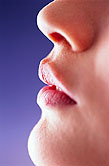Mouth Swab May One Day Diagnose Lung Cancer
It offers prospect of quick, noninvasive identification of the dangerous disease.
By Alan Mozes
HealthDay Reporter
|
E-mail this article
Subscribe to news
Printer friendly version
|

(SOURCES: Li Mao, M.D., professor, thoracic/head and neck medical oncology, and systems biology, the University of Texas M.D. Anderson Cancer Center, Houston; Stanton A. Glantz, Ph.D., professor, medicine, and director, Center for Tobacco Control Research and Education, University of California, San Francisco; April 16, 2008, presentations, American Association for Cancer Research annual meeting, San Diego)
WEDNESDAY, April 16 (HealthDay News) -- Doctors may some day be able to diagnose lung cancer with nothing more than a quick swab of the mouth, a new study suggests.
Oral cavity tissue damage -- at the molecular level -- appears to be a highly accurate indicator of similar lung tissue damage following long-term exposure to tobacco carcinogens, the researchers said. The prospect of such a novel diagnostic technique raises hope for a faster, easier and much less painful means to diagnosis lung cancer, they added.
"We tried to figure out whether oral cells mimic or reflect tobacco-induced damage in the lung," said study senior author Dr. Li Mao, a professor of thoracic/head and neck medical oncology, as well as systems biology, at the University of Texas M.D. Anderson Cancer Center in Houston. "And what we found is that more than 90 percent of the time you see the same abnormalities in oral cells that you see in lung tissue."
Mao discussed his findings during a Wednesday teleconference at the American Association for Cancer Research annual meeting, in San Diego.
Following Mao's presentation, the results of other studies concerning similar diagnostic advances in other fields of cancer research were presented.
Researchers from Henry Ford Hospital in Detroit said that an analysis of DNA extracted from saliva might ultimately enable physicians to detect early signs of head and neck squamous cell carcinoma -- a disease that currently affects 40,000 Americans.
Scientists from the Dana-Farber Cancer Institute in Boston provided evidence that fallopian tube tissue -- rather than ovarian surface cells -- could be the source for half of all cases of sporadic and hereditary serous carcinoma, the most aggressive form of ovarian cancer. The finding could lead to earlier detection of a disease that currently affects about 200,000 women worldwide.
And a team from the Spanish National Cancer Research Center offered indications that a new way of analyzing antibodies in the blood could lead to a noninvasive way to screen for bladder cancer.
For their lung cancer investigation, Mao and his colleagues examined and compared harmful genetic modifications in a total of 1,774 mouth and lung tissue samples taken from 127 chronic smokers participating in a larger cancer prevention study.
In the sampled DNA, the researchers looked for evidence of a harmful molecular change that short-circuits the function of two genes normally effective at halting tumor growth.
After two analyses conducted over a three-month period, the researchers found that tissue damage of this kind was present almost equally in both mouth and lung tissue. In theory, this makes oral cavity sampling nearly as effective as lung tissue sampling for diagnosing lung cancer.
"There were some folks who didn't show abnormalities in their oral tissue even when there were some in the lung tissue," Mao cautioned. "And we do have more research to do. But I already think it's a very important finding, in that this opens the door to a noninvasive diagnostic method."
He added, however, that it will "take some time" before a practical diagnostic tool based on the current observations can be designed.
Stanton A. Glantz, a professor of medicine and director of the Center for Tobacco Control Research and Education at the University of California, San Francisco, called Mao's line of inquiry "interesting," but as a diagnostic application "not ready for prime time."
"I would put this in the category of interesting observations that might lead somewhere, but I'm skeptical," he said. "Certainly, they might be on to something. And there's clearly a relationship between the molecular changes in the cells in the mouth and the lungs. They're clearly correlated with each other, which means they tend to increase together. But whether or not the relationship is tight enough in an individual patient to be useful in diagnosis is still way too early to tell."
"But it may well be that as they [the researchers] refine something like this, it might end up helping to identify patients at risk who are worth investigating further," Glantz added.
More information
To learn more about lung cancer, visit the American Cancer Society. 
Copyright © 2008 ScoutNews, LLC. All rights reserved. 
HealthDayNews articles are derived from various sources and do not reflect federal policy. healthfinder.gov does not endorse opinions, products, or services that may appear in news stories. For more information on health topics in the news, visit the healthfinder.gov health library.